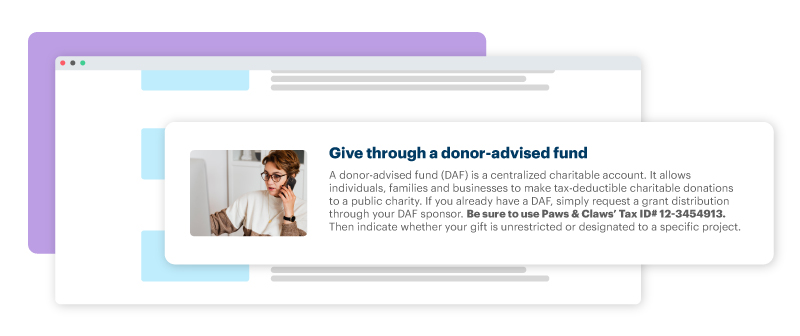Nonprofit Technology & Fundraising Blog
Subscribe to our mailing list

February 16, 2023 |
Knowing how donors prefer to give has always been essential for fundraisers to understand, but the number of ways in which a donor can give has never been so vast. From online forms to mobile text messages to QR codes, there are countless avenues for a donor to contribute, and navigating this can be difficult. Staying on top of these trends is vital, but it is also essential to cut through the noise to identify giving trends with real staying power.
One such trend that has been rising in popularity for the past few years is the donor-advised fund (DAF). Donor-advised funds are easily established by an individual, and many only require a minimal contribution amount. After a donor makes a contribution, they can recommend charitable grants to be distributed to organizations of their choosing. This is a growing industry with a lot of money behind it. From 2020 to 2021 DAF giving increased by 28%, and in 2021 DAF grants to charities totaled $45 billion.
With this kind of financial weight, soliciting donor-advised funds should play an integral role in your organization’s strategic plan. When crafting targeted outreach to solicit from donor-advised funds, it’s helpful to know your donors’ motivations in using this financial tool to begin with. Knowing more about the type of donor who uses a DAF account, and the advantages they accrue through them, can provide insight into what they value in philanthropic relationships.
Some donors use DAFs for the immediate tax benefit. It’s a financially-driven choice designed to give the individual more time to make an informed decision about the type of charity they would like to support. To this type of donor, the details are important. They are not the type of donor who will contribute to your year-end appeal at 11:50 pm on New Year’s Eve.
Outreach to this donor should be thorough. If a donor has expressed interest in contributing to you through their DAF account, you may consider a phone conversation. A phone call will give you the opportunity to delve deeper into their motivational drivers to discover what about your mission speaks to them.
Consider that this donor may not contribute to you in the immediate future, but rather at a specific time in their life. DAFs do not have a minimum distribution amount per year (though many DAFs do distribute significant portions of their revenue each year). So your donor with a DAF may have a giving plan in mind that may not begin until their retirement or later. However, if you wait to cultivate a donor until their retirement, chances are their plan has already been set in place. Early relationship building, even with donors who do not plan on giving for some time, is essential.

Although many DAF accounts have low thresholds (the initial deposit amount to establish an account), the average amount in 2021 was estimated at a sizeable $133,646. Considering the likelihood of a larger amount, it is a safe practice to treat your DAF donors in the same way you would approach a major donor.
An individual may use a donor-advised fund because they are thinking long-term, about creating a legacy and a way for their family to be involved in charitable giving. When a donor creates a DAF, they can name the fund after themselves or their family, and they can name joint, secondary, and successor advisors, which may include spouses, children, and even grandchildren.
With donors interested in creating a legacy, it’s important to include family in your solicitations. Not only will this speak volumes to your primary donor, but it will also start the cultivation process with the potential successors and decision-makers of their donor-advised fund. Hosting family-friendly events such as a volunteer day or a picnic is a great way to include all ages.
Donors can make investments with the funds they contribute to a donor-advised fund. These investments can grow tax-free, allowing them to donate more than they initially contributed as they distribute the funds. Following a similar pattern, this type of donor is not looking to contribute immediately to your organization. Instead, they will allow their investments to grow over time, hoping to accumulate additional gains that they can later give to charity.
For donors that are financially savvy, they may be particularly interested in how you allocate resources at your organization. Let your contributors and prospects know how you use funds and the positive and effective impact you are having on your community. Highlight your frugality too if you have a robust volunteer program.
Not sure about the value of your volunteer hours? The value of a single volunteer hour is estimated to be approximately $29 an hour! You can easily use DonorPerfect to track and report on your volunteer hours too.
Many individuals effectively use donor-advised funds in order to simplify donating complicated assets. Many nonprofits do not have the time, expertise, or resources to handle contributions of real estate, stocks, life insurance, and cryptocurrency. Donor-advised funds, on the other hand, are well equipped to handle the liquidation and distribution of these types of assets.
Make sure your marketing materials and website include information about the types of donations you accept. If your website hosts a “Ways to Give” page, outline the benefits of donor-advised funds and how they can streamline the donation process for both you and your donors.

Pro-Tip: Make sure your donors know you are familiar with and happy to accept donations from donor-advised funds by listing them as a method of donation on your website. Also, remember, not every appeal you make may qualify for a donation from a DAF. Check common guidelines before making your request.
Another distinct advantage of donor-advised funds is having a centralized location of all charitable gifts for record keeping. A DAF streamlines a donor’s philanthropic donations; the donor makes one tax-deductible contribution to their DAF account, and can then distribute the funds to charities and causes of their choice through that account. At the end of the year, they will not have to track down or account for all the donations they’ve made when reporting on their taxes.
For donors looking to streamline their giving practices, you want to create a simplified giving experience for them. You can do this by ensuring that your donors know your organization is able to accept donor-advised funds. Ensure that all of your eligible solicitations include DAF language and provide whatever contact information your donors will need to proceed with a contribution.
Did you know? An average of 87% of charities who ask for a donor-advised fund gift receive a contribution within 3 years, compared with 42% of nonprofits who do not ask. Just soliciting a DAF gift increases your likelihood by a whopping 45%!
Donor-advised funds can be an excellent revenue builder for your organization and the more well-versed you are, the easier it will be to solicit these funds. Download your copy of Donor-Advised Funds – A Secret Source of Fundraising Revenue to learn more.
Follow us on social!